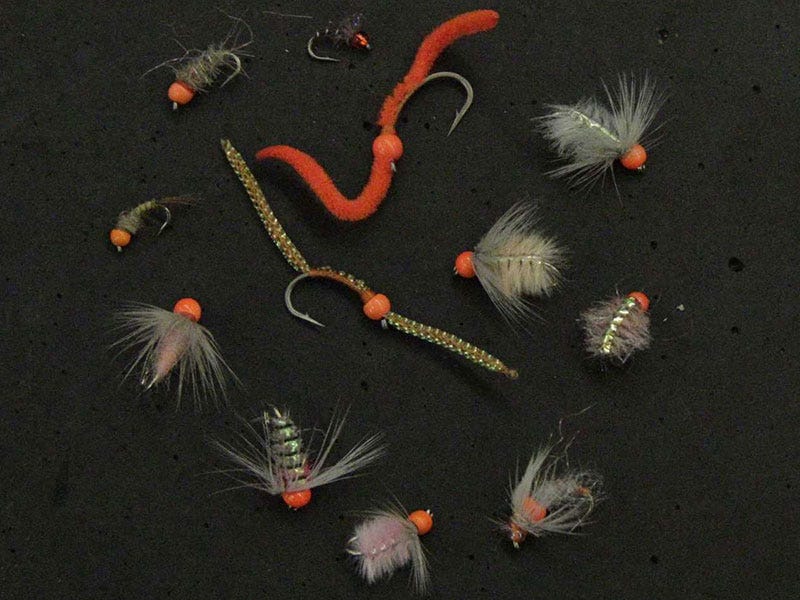Get in on Fire Bead Season

It’s winter time. For many anglers, that means fly tying season. Customers often come through the shop this time of year, pick up a few materials and lament on how long it’s been since they went fly fishing. My question is always why? If the weather isn’t terrible, why not go fishing in the winter? It’s Fire Bead Season.

Baby, it’s Cold Outside
Before we talk about fire bead flies, let’s explore what winter means to anglers and fish. People get cold in the winter. So, do trout. People can warm up with layers, hot beverages, and external heat sources. Trout are stuck with the temperature of the water they are swimming in. Advantage goes to the humans. Especially when they understand what that cold water does to the trout.
Layering up before heading out? We have you covered.
Trout metabolisms slow down considerably in icy cold water, but they will still eat. In a river like the Missouri, that has lots of food available, they keep eating steadily throughout the winter months. The difference is that their feeding periods will be shorter and will take place in very specific locations.
As fish begin to shift to winter levels of activity, it's trout swing season. Read this.
Cool water concentrates fish in moderate current zones. They will choose areas where they can easily reach food when they want to and then drop into deeper quiet waters to chillax when they are not feeding. These areas are predictable, and fish will move to these places for months at a time. Once you find them, you can keep going back and expect that they will be there, ready to eat a fire bead fly.
What is a Fire Bead Fly?
Simply put, a fire bead fly has a fire orange, orange or pink bead utilized in its construction. Often the bead is used at the head of the fly, but sometimes it will be used as a hotspot within the fly. Either way, the fire bead adds a spot of hot color contrasting with the primary materials of the fly.
Fire bead nymphs are generally of the scud and sow bug variety. A pink Ray Charles with a hot orange bead is a venerable favorite for wintertime nymphing. Fire beads can also increase the attraction of midge and mayfly nymph patterns and they are an excellent addition to buggers and leeches.
Why do Fire Bead Flies Work So Well?
There are a variety of explanations as to why fire bead flies work so well. One theory is that the patterns represent an egg. Anything that looks like an egg has potential, but I think it’s more than that. It’s about color and probability. Fish in a winter lethargy need a little spark to move toward a drifted fly. The fire bead provides the spark. Without a fire bead, the fly needs to drift really close to their mouth to get a response. With a fire bead, fish can be attracted from a greater distance. Think of a fire bead like the glow of a propane heater head when your fingers are frozen. The fire bead basically increases the distance fish will move to the fly, giving the angler more water coverage on every cast.
Get Some!
If you are a fly tyer, you can pick up a few packs of brass or tungsten beads in fluorescent orange, fluorescent flame, fluorescent pink, or salmon pink. The 3/32 inch is the most popular size for #16 hooks, but you can go larger or smaller as needed. If you want to buy your flies, we have lots of choices in popular patterns and sizes. We also have portable propane heaters.
Need the best fly tying materials delivered to your door? Order online here.
